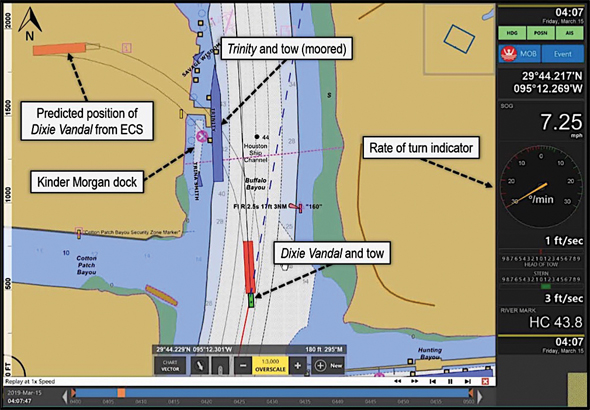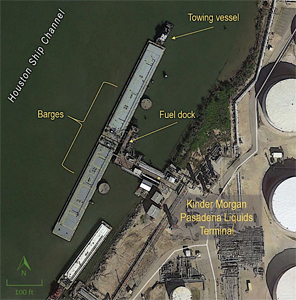At about 0400 on March 15, 2019, the towboat Dixie Vandal made an abrupt turn to port in the Houston Ship Channel near Pasadena, Texas. Less than a minute later, its tank barge hit the moored towboat Trinity and one of its barges at nearly 6 knots.
The impact at 0408 pushed Trinity’s tow 100 feet upriver. It also caused extensive damage to the Kinder Morgan Pasadena Liquids Terminal at mile 44 in the Houston Ship Channel. Pollution was limited to a half-gallon of jet fuel.
Dixie Vandal’s pilot told National Transportation Safety Board (NTSB) investigators he didn’t remember making the sudden turn. He also never heard the bridge navigational watch alarm system blaring.
“The pilot on Dixie Vandal told investigators that he believed he had dozed off in the seconds before striking Trinity and was awakened by the impact,” the NTSB said in its accident report. “He was unsure how the tow had turned to port.”
The agency attributed the accident to the fatigued pilot, who fell asleep and lost control of the tow likely just before impact. “Contributing to the pilot’s fatigue,” the report continued, “was the extended length of duty through the night and early morning hours and his use of an over-the-counter antihistamine.”
The pilot took the medication cetirizine, commonly known as Zyrtec, for allergy symptoms. The NTSB said the medication warns that drowsiness may occur, although the pilot said it did not make him tired.
Kirby Corp.’s Inland Marine Unit operated both Dixie Vandal and Trinity. A company spokesman did not respond to an inquiry about the NTSB findings. The report noted Dixie Vandal’s crew switched from a 12-on, 12-off watch rotation to two six-on, six-off watches each day following the incident.
Dixie Vandal’s pilot began his 12-hour watch at 1800 on March 14. The 1,200-hp vessel pushed the 297-foot tank barge Kirby 29751, which loaded refined petroleum products at 0100 on March 15 at Morgan’s Point. From there, the tow headed up the Houston Ship Channel toward City Docks in Houston.
Trinity, meanwhile, arrived at Kinder Morgan’s terminal at mile 44 late on March 13. The 1,400-hp towboat pushed the 297-foot tank barges Kirby 29051 and EBL 2997, arranged one in front of the other. The tow moored port side to the terminal.
 |
|
A screenshot captured at 04:07:47 from the playback of Dixie Vandal’s electronic chart system shows the towing vessel as it approached the Kinder Morgan facility. |
|
NTSB/Rose Point photo |
Dixie Vandal and its barge approached Trinity and its barges at about 0400 on March 15, with the pilot planning to pass the moored vessels port to port. Dixie Vandal’s electronic charting system showed the vessel suddenly turned to port.
“At 04:07:47, the rate of turn indicator on the electronic charting system reached its maximum display of 30 degrees to port,” the NTSB said in its report. “At 04:08:31, at a speed of about 6.5 mph, the forward port corner of (barge) Kirby 29751 contacted the starboard side of Trinity and then struck the forward port corner of barge Kirby 29051.”
The impact severed 12 mooring lines holding the tow in place and two cargo hoses, causing more than $500,000 in damage to the Kinder Morgan facility and about $100,000 to the barges. The half-gallon of residual jet fuel inside the hoses reached the waterway, according to the NTSB.
Dixie Vandal, like most towboats in the Kirby fleet, is equipped with a bridge navigational watch alarm system with motion sensors. The system sounds a wheelhouse alarm if there is no movement for more than 40 seconds. Another minute with no movement rings the general alarm. The pilot did not hear the wheelhouse alarm, and the general alarm did not sound, suggesting to investigators that the pilot dozed shortly before the impact.
The pilot at Dixie Vandal’s controls was on the 10th day of a 20-day work rotation with daily 1800-to-0600 watches. He told investigators he generally kept normal hours when not working on the towboat, and typically slept from 0800 to 1600 while off watch on the vessel. Dixie Vandal’s captain reported that the pilot appeared “more than fine” on the evening of March 14 and ready to complete his watch.
This evaluation occurred before the pilot began his watch under Kirby’s “watch readiness” policy. It entails crewmembers monitoring their peers to ensure they can perform their jobs safely. Kirby allows captains to temporarily tie up vessels or request relief if a crewmember feels too tired to complete their duties, the report said.
The report did not say how often these requests are made within Kirby’s vast fleet of inland vessels. However, a Kirby manager interviewed by the NTSB said such a request has been made, and granted, on Kirby vessels in the past. These practices aside, the NTSB warned of the challenges of staying awake and focused during the overnight hours.
“Self-reported (subjective) alertness, such as the pilot stating that he felt alert and awake for his shift, is often deceptive,” the report said.
The NTSB, which investigates a small fraction of maritime casualties, identified 14 incidents between 2014 and 2019 where fatigue was a leading factor. Ten occurred between 0100 and 0600 when the human body’s circadian rhythms are low. During these times, people often struggle to stay awake even if they are not overly fatigued.

